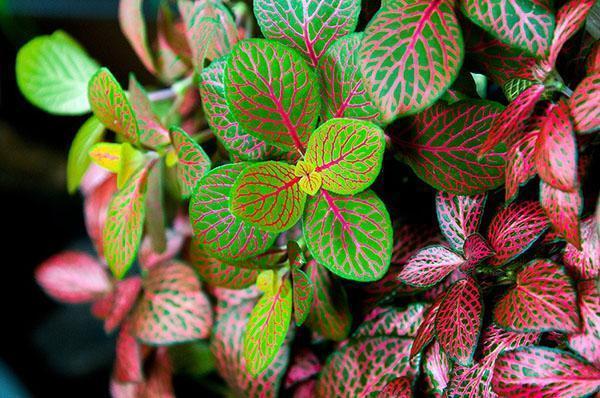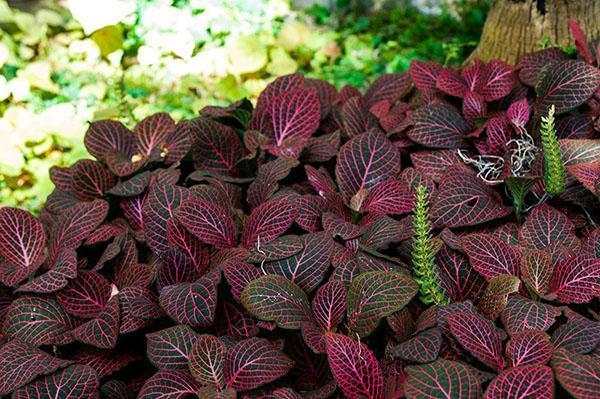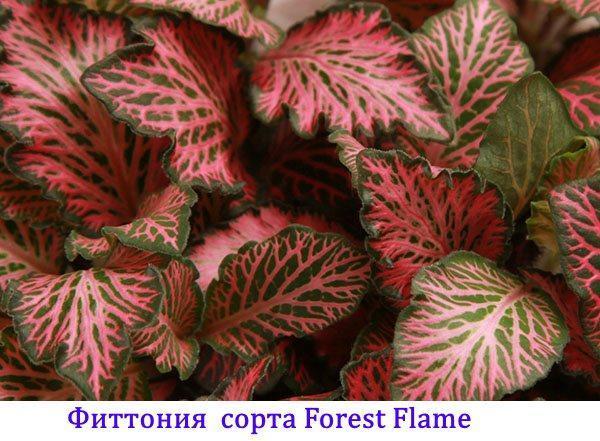Bright capricious woman: types of fittonia for growing at home
 The rainforests of South America are a haven for naturalists and botanists. Even in the century before last, among the lush greenery, scientists were attracted by decorative leafy species of Fittonia. In fact, the plant is not at all large, and if it were not for the original color of oval or ovoid leaves, the creeping shoots of Fittonia would have been waiting for their researcher for a long time.
The rainforests of South America are a haven for naturalists and botanists. Even in the century before last, among the lush greenery, scientists were attracted by decorative leafy species of Fittonia. In fact, the plant is not at all large, and if it were not for the original color of oval or ovoid leaves, the creeping shoots of Fittonia would have been waiting for their researcher for a long time.
But how to get past the green-pink, white-green, purple, violet or olive-carmine curtains?
Thanks to the incredible color of the leaves, named after the Fitton sisters, British popularizers of the botany Fittonia have become incredibly popular with amateur flower growers around the world.
Classifications and interesting facts about Fittonia

One school of botanists distinguishes three independent types:
- fittonia Vershaffelt (Fittonia vershaffeliti);
- Fittonia argyroneura (Fittonia argyroneura);
- giant fittonia (Fittonia gigantea).
However, this opinion has many opponents who believe that Fittonia is a single species, only with rare variability. Obviously, the proponents of both theories have their own arguments. We can only say for sure that the overwhelming majority of cultivated varieties of perennial herbaceous plants were obtained through selection work and are not found in nature.
From their natural progenitors, indoor Fittonia species received:
- love of moisture;
- a capricious disposition worthy of such bright beauties;
- climbing, creeping or erect shoots;
- inconspicuous white or yellowish flowers collected in spike-shaped inflorescences.
It is the imperceptible flowering that the plant owes to the brightness of the leaves, which serve as a bait for pollinating insects to fittonia.
In addition, there are some more interesting facts about Fittonia that will be interesting to her fans.
 The unusual color of the leaf plates serves as a warning to herbivores that can harm not only small plants, but also themselves. Although official sources do not mention the toxicity of certain types of Fittonia, locals have long collected and thawed its leaves. The drink obtained from them is used as a medicine for headaches and toothaches, as well as during Indian rituals as a hallucinogen.
The unusual color of the leaf plates serves as a warning to herbivores that can harm not only small plants, but also themselves. Although official sources do not mention the toxicity of certain types of Fittonia, locals have long collected and thawed its leaves. The drink obtained from them is used as a medicine for headaches and toothaches, as well as during Indian rituals as a hallucinogen.
Types of fittonia for home cultivation
Named after the German botanist of the 19th century, Fittonia Vershaffelt is a small herb. In nature and in pot culture, the flower is grown as a perennial. And its characteristic feature is eagerly branching creeping shoots, covered with pubescent ovoid or oval leaves.
 The Vershafelt Fittonia leaf plates cannot be confused with any other crop. The network of veins on them is painted in shades contrasting with the rest of it, which makes a 10-15 centimeter plant incredibly noticeable and unique. Getting on fertile soil, the shoots on the nodes quickly give rise to roots and take root. This variety traditionally includes plants with bright pink, purple, burgundy veins.
The Vershafelt Fittonia leaf plates cannot be confused with any other crop. The network of veins on them is painted in shades contrasting with the rest of it, which makes a 10-15 centimeter plant incredibly noticeable and unique. Getting on fertile soil, the shoots on the nodes quickly give rise to roots and take root. This variety traditionally includes plants with bright pink, purple, burgundy veins.
Flowering, like other types of Fittonia, is very modest. Green inflorescences-ears with single yellowish flowers covered with stipules appear above the green cap.
 Plants with white or silvery veins on a dark, purple, brownish or light green background are referred to the group of silver-veined fittonia. You can hear that this species is called White-tailed Fittonia, which is also true, but it is considered a somewhat outdated version of the name.
Plants with white or silvery veins on a dark, purple, brownish or light green background are referred to the group of silver-veined fittonia. You can hear that this species is called White-tailed Fittonia, which is also true, but it is considered a somewhat outdated version of the name.
Within the population there are rather large varieties, small-leaved varieties and real dwarfs, sincerely loved by gardeners who design terrariums and decorative aquariums. An example of such a dwarf fittonia is F. argyroneura Nana with leaves no more than 2–3 cm long.
 Fittonia the giant is a giant exclusively among its fellows. The height of the plant does not exceed half a meter, and the length of the velvety leaves, slightly compressed along the veins, reaches 15 cm. The flower owes its "record" size not to creeping, like in other species, but to erect or slightly lying stems.
Fittonia the giant is a giant exclusively among its fellows. The height of the plant does not exceed half a meter, and the length of the velvety leaves, slightly compressed along the veins, reaches 15 cm. The flower owes its "record" size not to creeping, like in other species, but to erect or slightly lying stems.
 Ovate leaves with a pointed tip can be either deep green or purple-purple. At the same time, the network of veins is not as noticeable as on small plants, and is painted in reddish or pinkish tones.
Ovate leaves with a pointed tip can be either deep green or purple-purple. At the same time, the network of veins is not as noticeable as on small plants, and is painted in reddish or pinkish tones.
Fittonia varieties for indoor floriculture
Flower shops most often offer flower growers small pots of young plants decorated with Fittonia Mix labels. Novices mistake the inscription for a variety name, but connoisseurs know that it is just a commercial name for hybrid plants for commercial use.
They are unpretentious, compact, decorative and suitable for growing in a pot or aquarium. However, in order to collect a truly precious collection of Fittonias, you should pay attention to varietal specimens.
 Indoor fittonia Fortissimo is distinguished by an oval or almost round shape of small leaves, on which a bright network of red-pink veins flaunts.
Indoor fittonia Fortissimo is distinguished by an oval or almost round shape of small leaves, on which a bright network of red-pink veins flaunts.
 The broad-lanceolate leaves of the Frankie Fittonia are painted in delicate pink or coral tones, on which the scattering of green splashes and the same delicate shuttlecock along the edge of the plate look especially exquisite.
The broad-lanceolate leaves of the Frankie Fittonia are painted in delicate pink or coral tones, on which the scattering of green splashes and the same delicate shuttlecock along the edge of the plate look especially exquisite.
 The magnificent Josan Fittonia combines all shades of red, coral pink, green. Young leaves are noticeably lighter. That perfectly highlights the centers of the rosettes and gives the whole curtain a wonderful volume.
The magnificent Josan Fittonia combines all shades of red, coral pink, green. Young leaves are noticeably lighter. That perfectly highlights the centers of the rosettes and gives the whole curtain a wonderful volume.
 Fittonia Red is addressed to original natures. This is a real riot of colors, and the traditional green here plays only the role of a thin edging.
Fittonia Red is addressed to original natures. This is a real riot of colors, and the traditional green here plays only the role of a thin edging.
 Breeders have long been working on entire collections of Fittonia varieties and hybrids. An example of this is the Red Vein Fittonia, part of the dedicated wine series, with dark green leaf plates pierced with bright wide red veins.
Breeders have long been working on entire collections of Fittonia varieties and hybrids. An example of this is the Red Vein Fittonia, part of the dedicated wine series, with dark green leaf plates pierced with bright wide red veins.
 Fittonia silver-veined Pink Vein is softer than its “sister” in the family. The plant has white-pink veins, the color of which is much richer on young foliage.
Fittonia silver-veined Pink Vein is softer than its “sister” in the family. The plant has white-pink veins, the color of which is much richer on young foliage.
 Fittonia White Vein has a fresh, spring green foliage and a snow-white vein network.
Fittonia White Vein has a fresh, spring green foliage and a snow-white vein network.
 Although White Anne is also a silver-veined Fittonia, it gives a very different impression. The leaf plates are corrugated along the edge and framed with a dark green border. And chalk white streaks, spreading, occupy the entire leaf area.
Although White Anne is also a silver-veined Fittonia, it gives a very different impression. The leaf plates are corrugated along the edge and framed with a dark green border. And chalk white streaks, spreading, occupy the entire leaf area.
 Fittonia Skeleton with greenish-yellow leaves dotted with a network of pink veins is especially recognized among flower growers.
Fittonia Skeleton with greenish-yellow leaves dotted with a network of pink veins is especially recognized among flower growers.
 Dwarf Fittonia Perseus belongs to the extensive group of Vershafelt fittonia. A small plant, barely reaching a height of 10–12 cm, has creeping pubescent stems covered with oval-pointed leaves. Pink or crimson veins are clearly visible on the green background color of the leaf plates.
Dwarf Fittonia Perseus belongs to the extensive group of Vershafelt fittonia. A small plant, barely reaching a height of 10–12 cm, has creeping pubescent stems covered with oval-pointed leaves. Pink or crimson veins are clearly visible on the green background color of the leaf plates.
 The original fittonia of Mosaic Kings Cross is most reminiscent of sea foam or exquisite lace. The corrugated pointed leaves are almost entirely white. The thinnest edging with a scattering of small splashes reminds of greenery.
The original fittonia of Mosaic Kings Cross is most reminiscent of sea foam or exquisite lace. The corrugated pointed leaves are almost entirely white. The thinnest edging with a scattering of small splashes reminds of greenery.